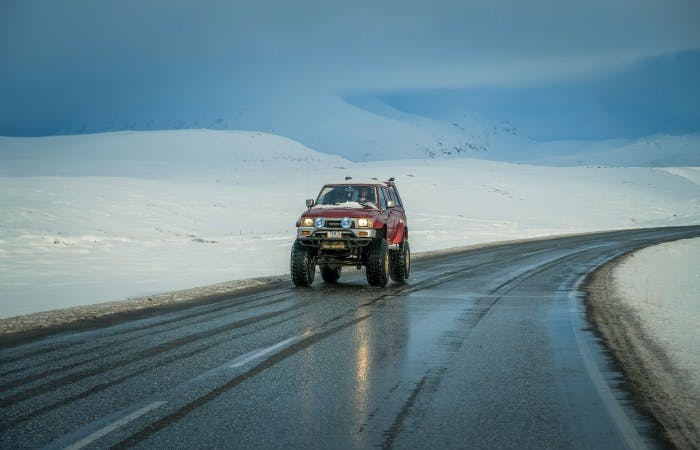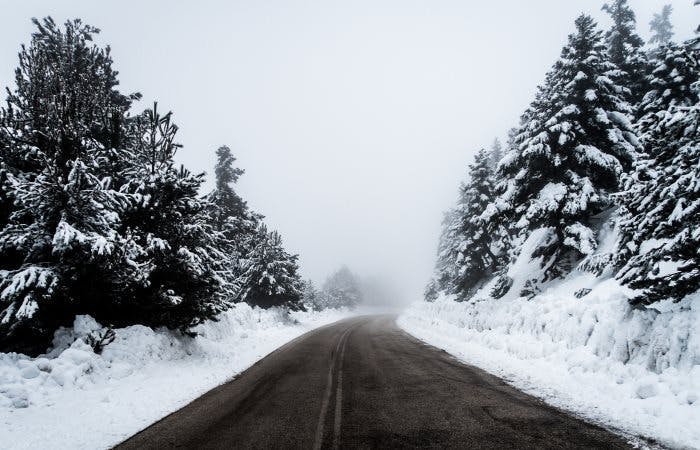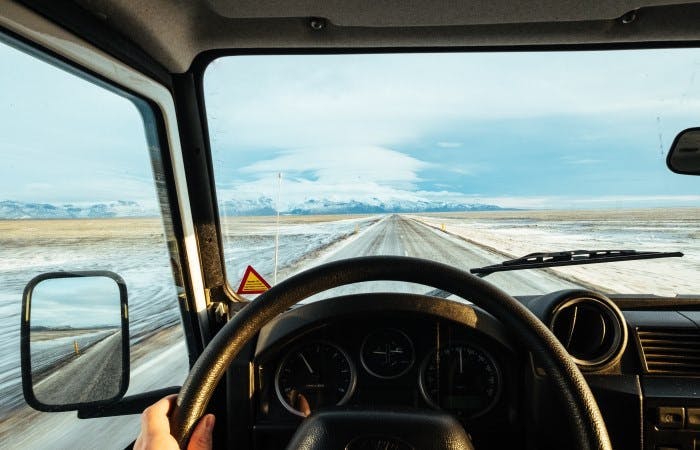
There's a good reason why people dislike driving in winter. It's because it can be extremely dangerous—at least, if you're not fully prepared for it. Not only have you got to deal with changes in traffic and road conditions due to fog, snow and ice, you've also got to be wary of reduced visibility. If that wasn't enough to have people swearing off driving during winter, there's another hidden threat to deal with: black ice.
If you want to stay safe on the roads in winter, it's important that you know how to deal with black ice. We're going to show you how to spot it, where it's most likely to develop and, best of all, give you some top tips so you can safely drive through it. Get the full lowdown below!
What is black ice and how can you spot it?
Black ice occurs when a layer of water freezes over the road, leaving a thin, glazed layer of ice. Despite the name, black ice is actually transparent. It gets its name from the dark colour of the road and pavement.
The reason that black ice is so dangerous is because it's hard to spot. If you're lucky, you'll be able to see a slight sheen on the road. If temperatures have been low, then it's likely to be black ice. If you're not so lucky, however, you won't actually notice it until you start to drive over it. With it being so difficult to gain traction on black ice, it can be all too easy to lose control and panic—especially if you're not properly prepared to face it. (We'll get to that part in the next section, don't worry!)
Black ice is more common on roads and areas that don't get much sunlight. Once the water freezes over the road and the temperature drops, the lack of sunlight means it's not going to clear up anytime soon. You're likely to find black ice on flyovers, roads shaded by trees, tunnels and roads at night.
What should I do if I encounter black ice?

Keep a cool head
We cannot stress this enough: panicking is the exact opposite of what you need to do when you encounter black ice. Obviously, it's a lot easier said than done. When something unexpected happens on the road, we can't help but freak out a little. What's important, however, is that you push past this feeling and try to remain as calm as possible. It's like any other situation on the road. You need to evaluate what's happening and take the best course of action to ensure you keep yourself and other road users safe.
Don't slam down on your brakes
One of our first instincts as a driver is to perform an emergency stop when we encounter a hazard. When it comes to black ice, however, slamming down on your brakes will make the situation much worse. It could cause your car to slide around uncontrollably, or even roll onto its side.
Slow things down a touch
The moment you realise you're driving on black ice, you need to slow things down. Keep both of your hands on the steering wheel and slowly take your foot off the accelerator pedal. You don't have to touch the brake pedal just yet—the reduction in speed should help you remain in control of your car as you continue moving over the ice. As you do, maintain your direction with a firm control of the steering wheel.
Just go with it
Let's say that you've slowed things down and you're making your way over the patch of black ice. Unfortunately, all of a sudden, you feel the rear of the car start to turn in a different direction. What do you do? Well, for starters, you should not, under any circumstances, try to fight it.
If you attempt to turn your steering wheel in the opposite direction to right yourself, your car could end up sliding out of control. Instead, what you need to do is go with it. If your car's moving to the left, then steer slightly to the left.
Try a bit of braking
So you've tried all of the above, but somehow, the situation has gotten a bit more dire. You're not slowing down and it seems like you're losing control of the car. What's next? As black ice tends to be pretty patchy, you do have a chance to gain traction. If you have an Anti-Lock Braking system, then put your foot down firmly on the brake pedal—your car will then pump the brakes for you. If you don't have ABS, then you'll have to pump your brakes lightly whilst gently steering your car in the direction you want it to head towards.
So now you know what you need to do if you come across black ice on the road. Next, we're going to take you through some top tips to help you prepare for driving in adverse conditions and also help reduce the risk of an accident.
Tips to deal with black ice safely
Before you set off

Figure out if you really need to travel
Even the most experienced driver can struggle when it comes to black ice. That's why, if you're sure your journey will involve black ice, or just overall icy conditions, you should carefully consider whether your trip is actually necessary. If it isn't, waiting a day or two can make all the difference—the ice might have thawed by then.
Think we're overreacting a tad? The Highway Code says differently. When it comes to icy or snowy conditions, it tells drivers “DO NOT drive in these conditions unless your journey is essential”.
Check in with the experts
So, you've decided that your trip can't wait. Before you get behind the wheel, however, there's one thing you need to do: check if it's actually safe to go ahead with your trip. For starters, have a look at your local weather forecast. If it's predicting dangerous weather, then you need to put your trip on hold. Next, check in with your local radio station to see if there are any major road closures. If they're telling drivers that it's too dangerous to travel, then listen. They're not doing it to mess up your plans. They're doing it to keep the public safe.
Get your car ready
Once you've determined that you're heading out, you need to make sure your car's ready for the journey. Start off by checking your windows and mirrors—you need to be able to see clearly out of them. If there's snow, ice or dirt blocking your view, then clear it away. You'll also want to double-check that all of your lights are in working order. You don't want to end up driving on the road (or worse still, broken down) with your headlights out of action.
Be prepared for the worst
If the worst case scenario happens, and you come across a rough patch of black ice and end up breaking down, you'll need to be prepared. The best way to do this is to make sure you're travelling with your essential car items. You could end up stuck on the side of the road for hours, so having a blanket to stay warm, for example, will go a long way. Other useful items include:
- Extra clothing
- Boots
- De-icer and ice scraper
- Torch
- First aid kit
- Jump leads
- Emergency food/drinks
Next item on your agenda: make sure you know what you're supposed to do in the event of your car breaking down. Don't worry—we've already done the legwork here. Read up on our handy guide to what to do when your car breaks down.
If you live in an area that deals with particularly bad icy conditions during winter, you might even want to consider switching your summer tyres for winter ones once the seasons start to change. Winter tyres are designed to give drivers better traction on snow and are also more durable for the adverse conditions.
Give yourself more time
If you're dealing with heavy snow or ice on the road, it's going to take you a lot longer to get to your destination. You'll be driving at a lower speed and will likely encounter road closures or delays along the way. As such, you'll need to allow more time for your journey. Don't head out with the intention of getting to your destination in the same amount of time it usually takes you—it won't happen.
When on the road

Take extra care
No matter how much of a rush you're in, you need to take extra care when driving in adverse conditions. Even if the roads have been gritted, you could still encounter black ice along the way. All it takes is a small patch to throw you off course.
So, drive at a slightly lower speed than usual. If you're going too quickly, you won't be able to take action until it's far too late. Next, make sure you're being extra vigilant with your hazard perception skills. If you notice the cars in front of you are slowing down, for example, it could be due to a change in road conditions.
Keep a safe distance
Whilst you might not have thought much about braking distances since you passed your theory test, they're something you need to take into account when driving in adverse conditions. According to the RAC, braking distances can be ten times greater on snow or ice—“that means, in the snow, it could take you further than the length of seven football pitches to stop from 70mph”.
If it's going to take you longer to come to a safe stop, then it's vital that you ensure there's plenty of space between you and the car in front. (That means no tailgating!)
Don't take unnecessary risks
Though this should be something you should bear in mind every time you drive, it's especially important when you're driving in icy conditions. If you're not sure you have enough time to safely emerge from a road, then wait until there's a large enough gap. Similarly, if you're not sure you've got enough time to safely overtake a vehicle, then wait it out. It's always better to be safe than sorry. It's not just your safety that's on the line when you take risks—it's the safety of other road users as well.
Subscribe for driving advice, offers & more
We'd love to let you know about our courses, news and offers via email. You may unsubscribe at any time.
Star Genie Limited trading as PassMeFast. Company number 10093359
Copyright © 2024 owned by Star Genie Limited
PassMeFast, Blue Tower, MediaCityUK, Salford, M50 2ST

